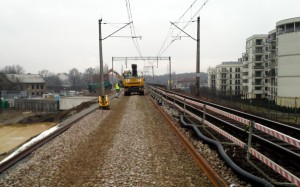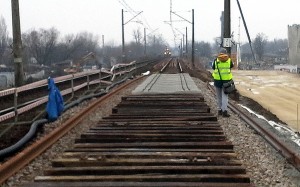New rails on the Zabłocie-Krzemionki connection
The construction of the strategic railroad section for Krakow and the entire Lesser Poland now enters the key stage. After months of preparations, the construction of the new railroad track finally begins. The construction works commissioned by the general contractor will be performed by KZN Rail, specialising in the key elements of railroad infrastructure.
 The investment project, which started last September, includes the construction of two railroad tracks running on over 2.5 km long viaduct between the railways Kraków Główny – Medyka (no. 91) and Kraków Płaszów – Oświęcim (no. 94). The railway viaducts will connect the completely remodelled passenger train stations Kraków Zabłocie and Kraków Krzemionki. The rail connection, i.e. railroad no. 624, will provide a direct railroad link on the line from Kraków Główny to Skawina and beyond, to Oświęcim and Zakopane. Prolonged stops and change of direction on Kraków Płaszów will no longer be necessary. This will shorten the travel time between Krakow and Zakopane by 15 minutes and will facilitate the commuter rail traffic to Zakopane, Skawina and Oświęcim.
The investment project, which started last September, includes the construction of two railroad tracks running on over 2.5 km long viaduct between the railways Kraków Główny – Medyka (no. 91) and Kraków Płaszów – Oświęcim (no. 94). The railway viaducts will connect the completely remodelled passenger train stations Kraków Zabłocie and Kraków Krzemionki. The rail connection, i.e. railroad no. 624, will provide a direct railroad link on the line from Kraków Główny to Skawina and beyond, to Oświęcim and Zakopane. Prolonged stops and change of direction on Kraków Płaszów will no longer be necessary. This will shorten the travel time between Krakow and Zakopane by 15 minutes and will facilitate the commuter rail traffic to Zakopane, Skawina and Oświęcim.
So far, the works included site preparation (demolitions) and construction of some of the piers for the two viaducts. “We are now starting the proper railroad phase, where the contractors, that is, Budimex and Ferrovial Agroman, entrusted the key role to our company,” says Grzegorz Leszczyński, Chairman of KZN Rail. “We will lay nearly 6 km of tracks. Of course, we will also incorporate the turnouts, which is our main specialisation. The swtiches will be supplied by the leader of our capital group, KZN “Bieżanów”, adds Mr. Leszczyński.
KZN Rail will begin the track works with laying the new track 1 on the railroad no. 91 in the vicinity of the new halt Kraków Zabłocie. “Right now, the old track has been completely dismantled and the new base has been partially constructed,” explains Aleksander Furtak, Board Member of KZN Rail. “Our job will be to make the ca. 500 m section of new tracks, together with the joint for a future railroad turnout, which will make it possible to enter the railway connection line no. 624,” adds Mr. Furtak.
 Right now, the entire commuter and long distance passenger traffic moves on the adjacent track no. 2. The trains will be rerouted to the new track once the construction is complete. Then, similar preparatory works will commence on track no. 2, i.e. the dismantlement of the old track bed and making the new base. “According to the plan, at that time we will move to Krzemionki, where we will incorporate two station turnouts. We will be working under pressure, as we will be linking track no. 1 to track no. 2 with both tracks disused, which means we will have to work 24/7. Then, we will return to line no. 91 and start working on track no. 2, with an identical joint for the new turnout,” explains Mr. Furtak.
Right now, the entire commuter and long distance passenger traffic moves on the adjacent track no. 2. The trains will be rerouted to the new track once the construction is complete. Then, similar preparatory works will commence on track no. 2, i.e. the dismantlement of the old track bed and making the new base. “According to the plan, at that time we will move to Krzemionki, where we will incorporate two station turnouts. We will be working under pressure, as we will be linking track no. 1 to track no. 2 with both tracks disused, which means we will have to work 24/7. Then, we will return to line no. 91 and start working on track no. 2, with an identical joint for the new turnout,” explains Mr. Furtak.
Clearly, KZN Rail will have to ensure high flexibility and mobility of their construction teams. The first stage of works must be completed before the World Youth Day in Krakow that will take place between 25 and 31 July 2016. “Immediately after the WYD, we want to incorporate the turnouts to connect line no. 91 with the railway connection. Due to the heavy traffic on Krakow’s cross-town railway line, which carries most long distance, regional and commuter traffic, we are seriously considering using the technology of incorporating turnouts in blocks with the Switcher cars, a proprietary solution developed by KZN Rail. This would significantly reduce the track disuse period and consequently, the problems for the passengers. Obviously, it would also mean higher costs, but I am certain that the time savings and the high quality and durability of turnouts delivered in blocks would be a reasonable alternative for the railway management authority. That is why we will try and convince all interested parties to that solution,” says Grzegorz Leszczyński.
The final stage will include the works in the vicinity of Krzemionki and the construction of the track bed on both parallel viaducts of the connection. Unlike the railroad fills made on that base, the rails will be laid on ypsilon steel sleepers rather than on pre-tensioned sleepers. According to the current schedule, the works on those sections should be performed at the turn of 2016 and 2017. All finishing works related to the rail surfaces should be completed by May next year.



